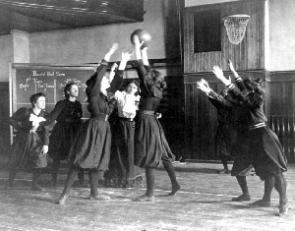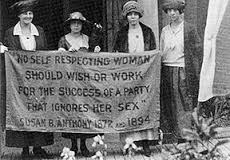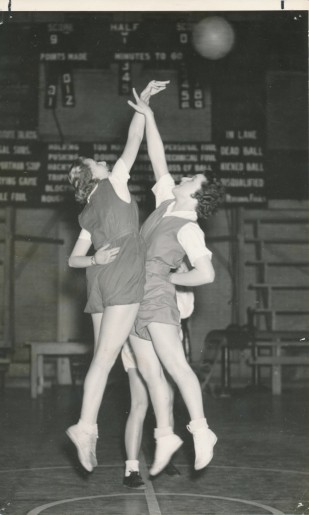Basketball was created by Naismith for boys, to keep them out of trouble, however, not long after the sport was invented, women soon began to adopt the game and have a love for it. In 1899, the Conference of Physical Training established a community to form uniform rules for women’s basketball, and in 1901, Sandra Berenson, the woman who created the first women’s basketball team, and Spalding established official rules for the game (Curry 1992). Some rules retained the aspect of men’s basketball, and other were intended specifically for women in the game.

Women playing basketball as an exhibition. Source: http://www.gilderlehrman.org/history-by-era/seventies/essays/impact-title-ix
Though there were many women involved in the sport at the time, it wasn’t always welcomed with open arms by everyone. The campus of Stanford University banned women’s basketball from intercollegiate competition, as did many other campuses, because they didn’t want women to take part in such activities that were associated with men in the fear that it would make women less feminine (Shakib 2002). It was obvious that there was a clear division between men and women, and that social rules were in place for what was thought to be acceptable for each gender.
The Progressive Era took its toll on America from 1890 to 1920. It was a period of social activism and political reform that shaped America’s being at the time by challenging social rules to expand their harness on women (Curry 1992). In the early 1900s, women really began to immerse themselves in the sport of basketball, and formed a passion to play the sport at the level the men did at the time. Basketball and women were two subjects that were never used in the same sentence, until a Native American team played women’s basketball at the St. Louis World Fair in 1904, as an exhibition (Nelson 1998). By taking a part in this exhibition, the team showcased the talents of women and the potential they had in playing the game that was originally intended for men, in public, for every person to stop and watch. As women started to break free from their “tight corsets” of life, society began to change around them.

Women fighting for control of their own destinies in the Progressive Era. Source: http://android-trick.biz/category/progressive
The exhibition was considered a public display of “rebellion” from women in society, and this sparked many fires amongst people and angered many men. According to them, societal rules were abridged and they wanted everything to return back to normalcy, with women behaving in the way they were socially restricted to do so. Four years after the exhibition, in 1908, the Amateur Athletic Union (AAU), sent out an announcement that women should not take part in playing basketball publicly (Nelson 1998). By putting out a statement like this during the Progressive Era, the union was making a bold statement and taking a stance against women, not with them, which during this time period caused quite a commotion.
After the public statement from the AAU, it was hard for women to play basketball and engage in the activity that they loved so much. Women believed that their social harness was becoming tighter, not looser by any chance. Moreover, after several years of banning the public playing of basketball by women, in the early 1920s, industrial leagues were formed (Shakib 2002). Industrial leagues were teams that were sponsored by companies for workers, male and female. With industrial leagues in place, it was the AAU who hosted the first ever national tournament for women’s basketball in 1926 (Nelson 1998). The organization of such teams was a prominent stepping stone in allowing women to play basketball, and furthermore, industrial leagues along with other reasons, would eventually lead to the formation of the Women’s National Basketball Association (WNBA) (Nelson 1998).

Women go head to head in a basketball tournament. Source: http://recollectionwisconsin.org/ripon-college-basketball
During the Progressive Era, as women started to become the “New Woman,” and become masters at writing their own destinies, they challenged societal rules and changed the way that they were perceived. Although it’s called the Flapper era, it is also considered an era where basketball was redefined for women and by women. Associations and leagues were formed for women so that they could participate in the sport they loved, just as the men did.
Source: 1) Curry, Jane. “American Women and Sport.” OAH Magazine of History 7.1, History of Sport, Recreation, and Leisure (1992): 39-49. JSTOR. Web. 15 Feb. 2015. 2) Nelson, Mariah Burton., and Lissa Smith. Nike Is a Goddess: The History of Women in Sports. New York: Atlantic Monthly, 1998. Print. 3) Shakib, Sohaila. “The Social Construction of Female and Male High School Basketball Participation: Reproducing the Gender Order Through a Two-Tiered Sporting Institution.” Sociological Perspectives 45.4 (2002): 353-78. JSTOR. Web. 15 Feb. 2015.